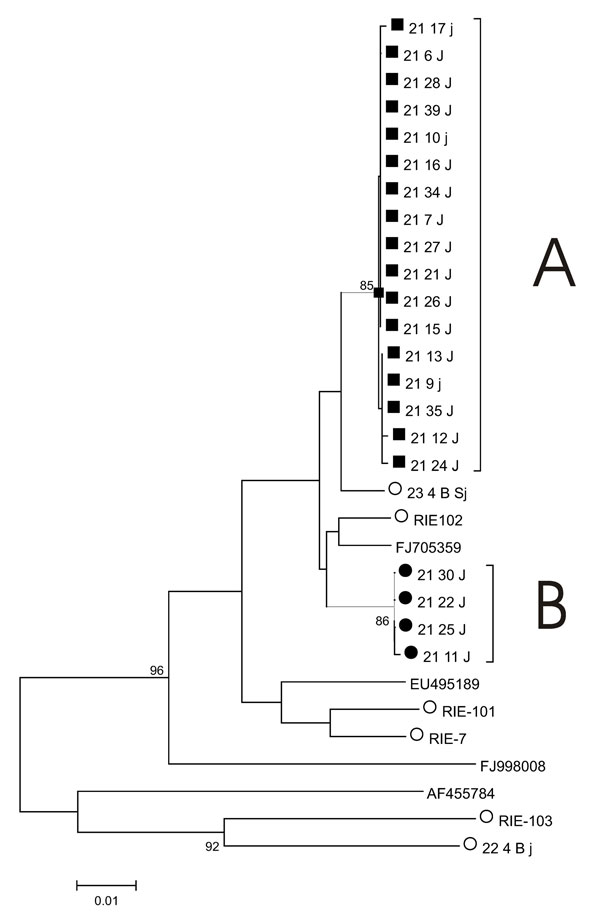Volume 19, Number 3—March 2013
Dispatch
Hepatitis E Virus Mixed Infection in Immunocompetent Patient
Figure

Figure. . . Phylogenetic tree of hepatitis E virus hypervariable region variants. A neighbor-joining tree of hypervariable region sequences was constructed by using MEGA 4 (15). A and B indicate sequences for virus populations A and B. Sequences from the patient studied here (patient 21) belonging to virus population A are indicated by a solid square, and those belonging to virus population B are indicated by a solid circle. Other sequences obtained in the same laboratory are indicated by an open circle. Closely related genotype 3 sequences obtained from GenBank are identified by their accession number. Bootstrap support (1,000 replicates) for branches of >70% are indicated. Scale bar indicates nucleotide substitutions per site.
References
- Moal V, Gerolami R, Colson P. First human case of co-infection with two different subtypes of hepatitis E virus. Intervirology. 2012;55:484–7 and. DOIPubMedGoogle Scholar
- Nguyen HT, Torian U, Faulk K, Mather K, Engle RE, Thompson E, A naturally occurring human/hepatitis E recombinant virus predominates in serum but not in faeces of a chronic hepatitis E patient and has a growth advantage in cell culture. J Gen Virol. 2012;93:526–30 and. DOIPubMedGoogle Scholar
- Kamar N, Bendall R, Legrand-Abravanel F, Xia NS, Ijaz S, Izopet J, Hepatitis E. Lancet. 2012;379:2477–88 and. DOIPubMedGoogle Scholar
- Takahashi M, Nishizawa T, Yoshikawa A, Sato S, Isoda N, Ido K, Identification of two distinct genotypes of hepatitis E virus in a Japanese patient with acute hepatitis who had not travelled abroad. J Gen Virol. 2002;83:1931–40 .PubMedGoogle Scholar
- Shrestha SM, Shrestha S, Tsuda F, Nishizawa T, Gotanda Y, Takeda N, Molecular investigation of hepatitis E virus infection in patients with acute hepatitis in Kathmandu, Nepal. J Med Virol. 2003;69:207–14 and. DOIPubMedGoogle Scholar
- Smith DB, Vanek J, Ramalingam S, Johannessen I, Templeton K, Simmonds P. Evolution of the hepatitis E virus hypervariable region. J Gen Virol. 2012;93:2408–18 and. DOIPubMedGoogle Scholar
- Takahashi K, Toyota J, Karino Y, Kang JH, Maekubo H, Abe N, Estimation of the mutation rate of hepatitis E virus based on a set of closely related 7.5-year-apart isolates from Sapporo, Japan. Hepatol Res. 2004;29:212–5 and. DOIPubMedGoogle Scholar
- Abe K, Inchauspe G, Fujisawa K. Genomic characterisation and mutation rate of hepatitis C virus isolated from a patient who contracted hepatitis during an epidemic on non-A, non-B hepatitis in Japan. J Gen Virol. 1992;73:2725–9 and. DOIPubMedGoogle Scholar
- Colson P, Borentain P, Queyriaux B, Kaba M, Moal V, Gallian P, Pig liver sausage as a source of hepatitis E virus transmission to humans. J Infect Dis. 2010;202:825–34 and. DOIPubMedGoogle Scholar
- Di Bartolo I, Diez-Valcarce M, Vasickova P, Kralik P, Hernandez M, Angeloni G, Hepatitis E virus in pork production chain in Czech Republic, Italy, and Spain, 2010. Emerg Infect Dis. 2012;18:1282–9 and. DOIPubMedGoogle Scholar
- Lewis HC, Boisson S, Ijaz S, Hewitt K, Ngui SL, Boxall E, Hepatitis E in England and Wales. Emerg Infect Dis. 2008;14:165–7 and. DOIPubMedGoogle Scholar
- Ijaz S, Szypulska R, Tettmar KI, Kitchen A, Tedder RS. Detection of hepatitis E virus RNA in plasma mini-pools from blood donors in England. Vox Sang. 2012;102:272 and. DOIPubMedGoogle Scholar
- Dalton HR, Stableforth W, Thurairajah P, Hazeldine S, Remnarace R, Usama W, Autochthonous hepatitis E in Southwest England: natural history, complications and seasonal variation, and hepatitis E virus IgG seroprevalence in blood donors, the elderly and patients with chronic liver disease. Eur J Gastroenterol Hepatol. 2008;20:784–90 and. DOIPubMedGoogle Scholar
- Wang H, Zhang W, Ni B, Shen H, Song Y, Wang X, Recombination analysis reveals a double recombination event in hepatitis E virus. Virol J. 2010;7:129. DOIPubMedGoogle Scholar
- Tamura K, Dudley J, Nei M, Kumar S. MEGA4: Molecular Evolutionary Genetics Analysis (MEGA) software version 4.0. Mol Biol Evol. 2007;24:1596–9 and. DOIPubMedGoogle Scholar
Page created: February 12, 2013
Page updated: February 12, 2013
Page reviewed: February 12, 2013
The conclusions, findings, and opinions expressed by authors contributing to this journal do not necessarily reflect the official position of the U.S. Department of Health and Human Services, the Public Health Service, the Centers for Disease Control and Prevention, or the authors' affiliated institutions. Use of trade names is for identification only and does not imply endorsement by any of the groups named above.